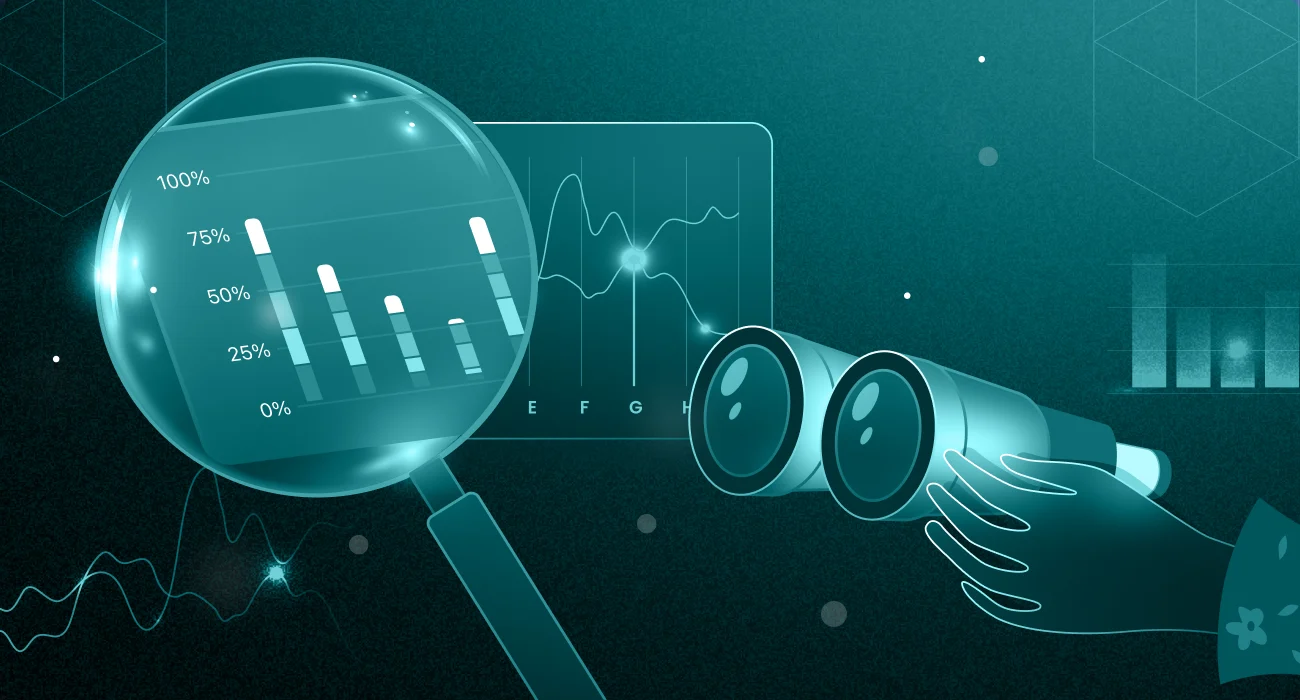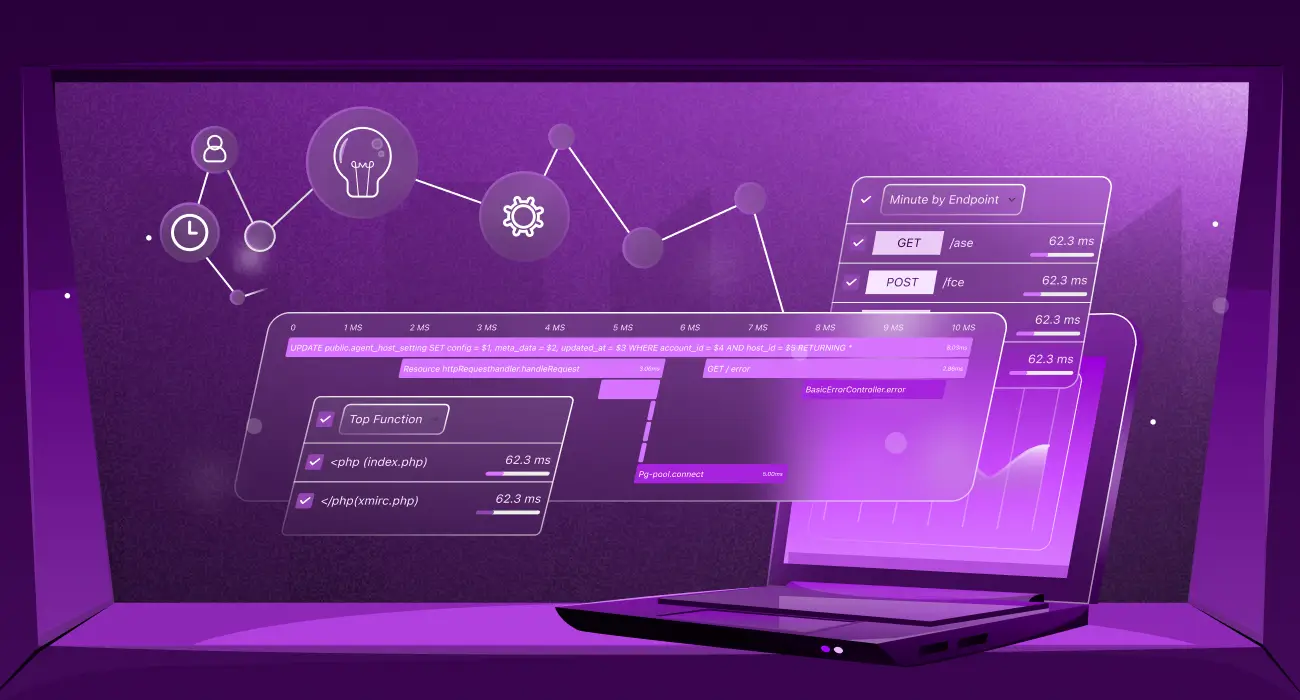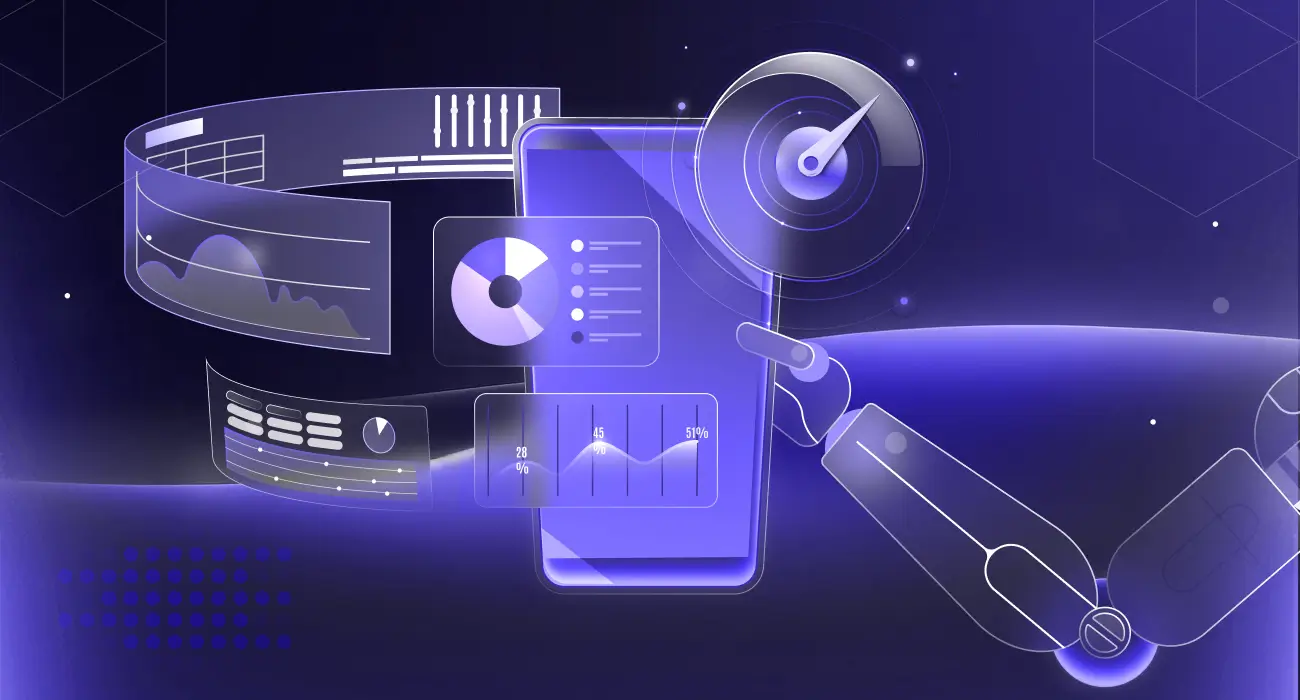Downtime hurts. A single outage can cost organizations hundreds of thousands of dollars and hours of lost productivity. According to the JumpCloud report, 80% of data centers experienced at least one outage in the past three years, with 60% of those costing more than $100,000.
That’s why businesses are investing in infrastructure monitoring, a critical practice to proactively detect, troubleshoot, and prevent system issues before they escalate.
But how do you know if your infrastructure is healthy? What should you look for? How do you monitor various parts of your network and servers?
This comprehensive guide will answer these questions and more!
What is Infrastructure Monitoring?
Infrastructure monitoring is the process of collecting and analyzing data about a system or application. It can be used to detect and identify issues before they impact users, as well as to identify and resolve issues after users are impacted.
“A recent DPS Telecom analysis based on the Uptime Institute’s 2025 report shows that while outage frequency is slightly down, configuration errors and power failures remain persistent risks, reinforcing the need for proactive monitoring.”
Modern infrastructure monitoring tools empower DevOps and IT teams with real-time visibility, automated alerts, and performance insights, helping reduce downtime, improve system reliability, and meet SLAs.
⚠️Start monitoring smarter with Middleware’s platform before your next incident surprises you.
Types of Infrastructure Monitoring
There are two main types of infrastructure monitoring: agentless and agent-based. Both have their advantages and challenges, so an ideal solution would be to use one that meets your requirements:
Agentless Monitoring
Agentless infrastructure monitoring is a method of monitoring the performance and status of computer systems and network devices without the need for installing software agents on the monitored systems.
This method typically relies on technologies such as Simple Network Management Protocol (SNMP), Windows Management Instrumentation (WMI), and Hypertext Transfer Protocol (HTTP) to collect data from the monitored systems. The monitoring platform establishes a connection to the system using one of these protocols and can then collect data such as CPU usage, memory usage, disk usage, and network traffic.
Agentless monitoring is an efficient, low-overhead method of monitoring systems and network devices. It can be helpful in environments where a large number of systems need to be monitored.
Agent-Based monitoring
Agent-based monitoring is a powerful method for monitoring systems and network devices, providing granular details and information about system performance.
It can be beneficial in environments where detailed information about the systems being monitored is necessary or when agentless monitoring is impossible because of security reasons or other limitations.
Once the agents collect and report data to a central monitoring platform, the platform can be configured to collect specific data and alert on specific conditions. It is more flexible and customizable compared to agentless monitoring.
Agent-based monitoring also enables monitoring systems behind a firewall or other security measures, or it can provide monitoring information on systems not exposed to the network.
Another advantage of agent-based monitoring is that it can continue to collect data even if the network connection between the monitored system and the monitoring platform is lost. The agents can buffer the data and send it to the monitoring platform when the connection is re-established.
Agent-Based vs Agentless Infrastructure Monitoring
Many modern monitoring platforms combine both methods, using agentless monitoring for basic infrastructure (like routers or VMs) and agents for deeper insights into business-critical apps or secured environments.
| Feature | Agentless Monitoring | Agent-Based Monitoring |
| Installation | No software agents required | Requires installation of agents on each system |
| Performance Overhead | Minimal system resource usage | Moderate resource usage by agent processes |
| Visibility & Data Depth | Basic metrics (CPU, memory, disk, network) | Deep-level metrics, including application, logs, and process insights |
| Security Compatibility | May struggle with firewalls or secure networks | Works behind firewalls and in restricted environments |
| Offline Monitoring | Not possible; requires continuous connectivity | Agents buffer data and sync whenthe connection is restored |
| Scalability | Ideal for large-scale environments with limited system access | Best for environments needing detailed observability per host |
| Customization | Limited configuration or extensibility | Highly customizable with scripts, plugins, and custom integrations |
| Maintenance | Low maintenance (no need to update agents) | Requires version control and agent updates |
How Infrastructure Monitoring Works
Infrastructure monitoring tracks the performance, availability, and resource utilization of containers, hosts, and other backend components.
Infrastructure monitoring typically entails instrumenting a host by installing an agent. With Middleware infrastructure monitoring, the process is streamlined through a guided installation. Our intelligent agent automatically detects:
- Running applications and services
- Active log sources
- Host resource configurations
Based on what it discovers, it recommends and configures the most appropriate setup tailored to your environment.
Real-Time Data Collection and Processing
Once installed, the Middleware agent collects system-level data continuously and sends it to our monitoring backend. Which real-time data further,
- Detect anomalies or performance issues
- Trigger alerts if predefined thresholds are breached
- Visualize historical trends and real-time system states
Unified Dashboard View
All collected telemetry is aggregated and presented in a centralized, unified dashboard, giving DevOps and SRE teams clear visibility into infrastructure performance from the OS level to container orchestration layers. Whether you’re running workloads on physical servers, VMs, or Kubernetes clusters, Middleware ensures you have full-stack observability.
Here’s a small architecture diagram showing you how Middleware collects and processes your data to provide you with robust Infrastructure monitoring:
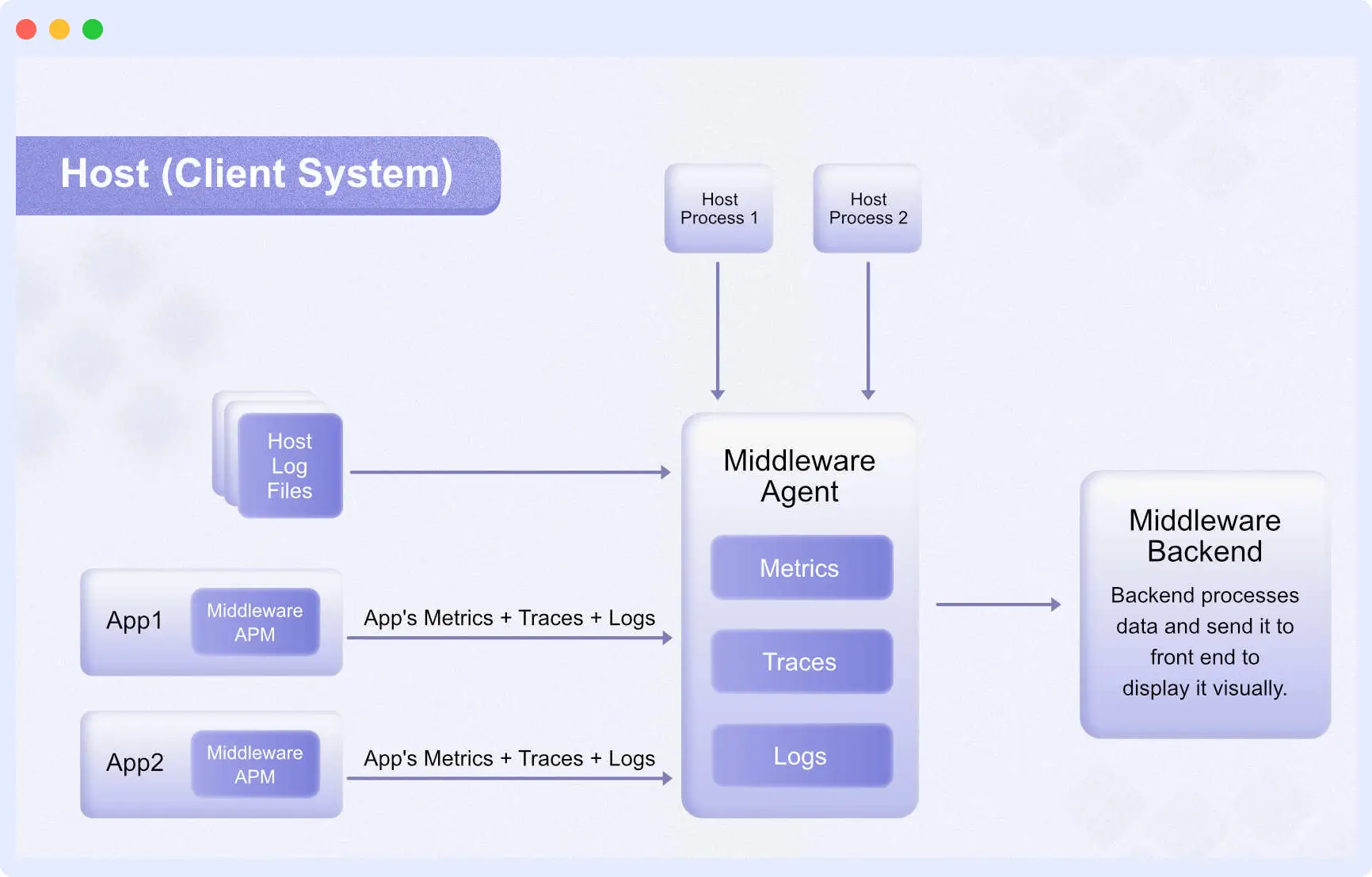
What are the Benefits of Infrastructure Monitoring?
The primary benefit of infrastructure monitoring is the ability to react to worst-case scenarios proactively, saving Dev’s time and Ops’ money. As a result, infrastructure monitoring is always at the core of every operation.
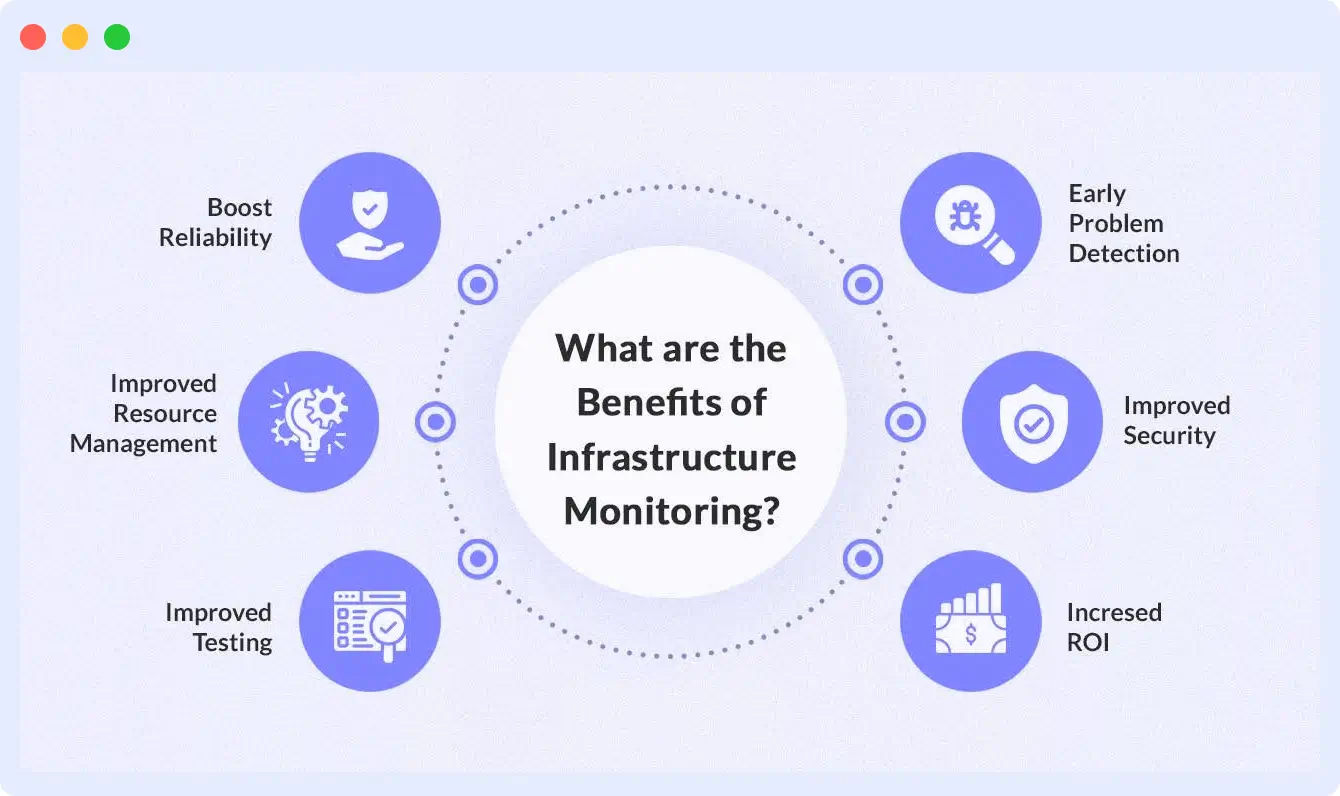
Once implemented well, you’ll get the following benefits:
1. Early Issue Detection
Infrastructure monitoring allows IT teams to catch even small issues before they escalate into system-wide outages.
- How: By setting thresholds and monitoring metrics (CPU, memory, disk I/O, etc.), the system can trigger alerts on unusual behavior.
- Example: A financial services company noticed that a particular backend API consumed abnormal memory after each release. Monitoring helped flag this early, leading to a rollback before customer-facing downtime occurred.
- Impact: Reduces Mean Time to Detect (MTTD) and improves incident response.
2. Higher System Reliability
With continuous monitoring, DevOps teams can quickly pinpoint and resolve incidents, reducing downtime and boosting service reliability. This directly improves user satisfaction and trust.
- How: Infrastructure Monitoring Tools collect heartbeat data from servers, services, and databases to detect service degradation or failure.
- Example: An e-commerce platform used monitoring to detect a failing load balancer node that would have otherwise taken down 40% of traffic during a holiday sale.
- Impact: Guarantees SLAs (Service Level Agreements), improves business continuity, and reduces customer churn due to downtime.
3. Optimized Resource Utilization
Infrastructure Monitoring helps identify underused or over-provisioned infrastructure components. You can right-size your resources to avoid waste while ensuring systems have what they need to perform.
- How: Track CPU, memory, and disk usage over time to spot patterns of not using resources.
- Example: Discovering a set of VMs consistently running under 20% CPU load can justify downsizing or consolidation.
- Impact: Saves cloud or on-premise costs, improves infrastructure efficiency.
4. Safer Deployments and Testing
Infrastructure monitoring provides insight during deployments or configuration changes, ensuring new updates don’t negatively impact performance. It supports smoother rollouts and post-deployment validation.
- How: Real-time insights can catch regressions, slowdowns, or crashes after code updates or infrastructure changes.
- Example: After deploying a new microservice, infrastructure monitoring may reveal a sudden increase in response times or failed connections.
- Impact: Enables rapid rollback or fixes, improving developer confidence and velocity.
5. Enhanced Security Visibility
By tracking access patterns, configurations, and unusual system behavior, monitoring tools can surface potential security threats such as privilege escalations or unauthorized access early in the lifecycle.
- How: Tracks unexpected spikes in network traffic, unauthorized access attempts, escalation, and configuration changes.
- Example: Detecting unusual SSH login attempts from foreign IPs can indicate a potential breach.
- Impact: Acts as a first line of defense..
6. Increase ROI for IT Operations
Monitoring reduces the manual effort required for system oversight and troubleshooting. Further, DevOps and SRE teams devote less effort to monitoring your IT systems and more time to providing better value to your end-users.
- How: Automates data collection, alerting, and diagnostics, reducing reliance on manual checks or reactive firefighting.
- Example: Automate detection of high CPU spikes across hundreds of containers. Instead of manual log reviews, engineers received pre-filtered alerts with actionable diagnostics, cutting down investigation time by 60%.
- Impact: Lowers operational overhead, improves team productivity, and increases return on investment from infrastructure and human resources.
Infrastructure Monitoring Use Cases
Operations teams, SREs (site reliability engineers), and DevOps engineers generally use infrastructure monitoring to help them:
1. Troubleshoot Performance Issues
Infrastructure monitoring is commonly used to prevent issues from turning into outages. An infrastructure monitoring tool can display which hosts, containers, or other backend components failed or encountered latency during an incident. Engineers can also identify which hosts or containers were down when an outage occurred.
Generation eSports was frustrated with slow alerts via Datadog, and the team turned to Middleware, which not only sped up troubleshooting but also helped avoid major incidents altogether. Outcome: 75% faster MTTR and 75% cost reduction.
“There was a point where I had to use a separate tool just to log into our Kubernetes (K8) cluster and check if any pods had crashed. Now, I simply rely on Middleware’s alerts, which are reliable and fast”
Elijah Smith, Software Engineer III at Generation Esports
“Pro Tip: According to AWS, up to 60% of system failures could be proactively avoided with intelligent visibility and alerting.”
2. Network & Infrastructure Performance Management
Many Infrastructure monitoring tools also offer separate solutions for network and infrastructure performance management or include application monitoring in a suite of their monitoring services.
Depending on your solution, you can ensure that your applications aren’t negatively affecting your network or the rest of your Infrastructure. Since today’s applications can take up a significant chunk of network resources, your company must ensure that they have the proper Infrastructure to support its business applications.
Alternatively, you may have a network monitoring solution that can contain APM capabilities. These tools usually examine application performance from a network perspective, showing how your business apps affect network performance and security.
Middleware’s unified dashboards provide end-to-end visibility across hosts, containers, Kubernetes clusters, and cloud services, including AWS and Azure integration for insightful metrics and root cause correlation.
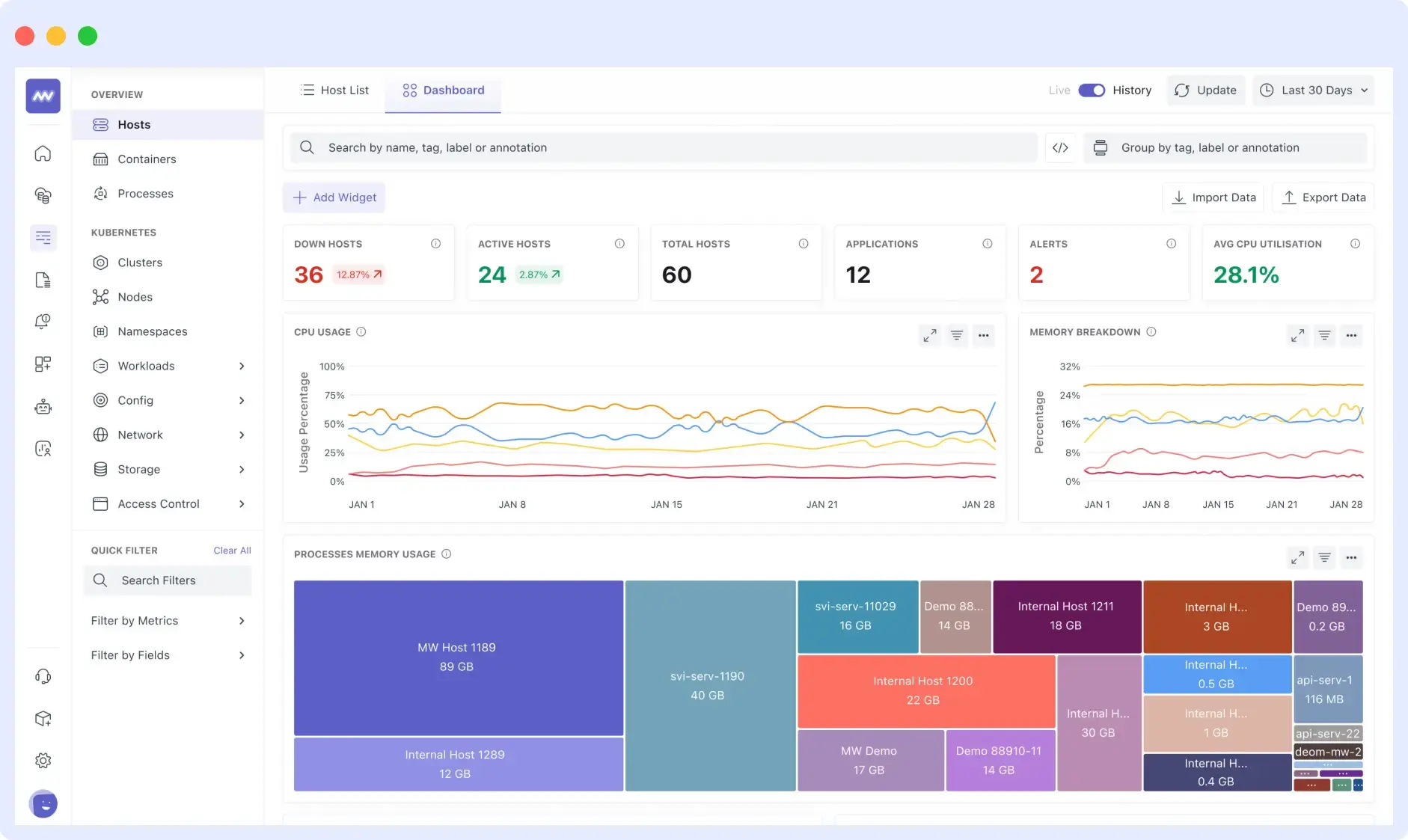
“Example: An app with high bandwidth usage might slow down other services. Monitoring ensures balanced resource distribution.”
3. Forecast Backend Requirements
Businesses can anticipate future resource demand by looking at historical infrastructure measurements. For instance, if some hosts were under-provisioned during a recent product launch, you can specify additional CPU and RAM during similar events to reduce stress on crucial systems.
4. Configuration Assurance Testing
Configuration changes and feature updates can unintentionally break infrastructure. Infrastructure monitoring enables you to:
- Validate that updates don’t crash critical systems
- Continuously test configurations across environments (dev, staging, prod)
Middleware monitors real-time performance and flags errors, high resource usage, or deployment issues quickly, ideal for validating new releases or configuration changes in dev/staging/production environments.
“Popular among SMBs and mid-sized teams to ensure post-deployment stability.”
Key Infrastructure Monitoring Challenges
The rising complexity of the software development architecture has not only caused a rise in the existing IT monitoring challenges but has also introduced some new challenges, especially in the enterprise.
Here are the key Infrastructure monitoring challenges and their solutions
1. Too Many Monitoring Tools
Large organizations often rely on 8–10 different tools to monitor networks, applications, databases, logs, traces, storage, and more. Each tool comes with its own dashboard, making it nearly impossible to gain a centralized, real-time view of infrastructure health.
Challenge: Fragmented observability
Solution:
- Adopt unified observability solutions like Middleware, which aggregates data from diverse sources into a single, comprehensive dashboard.
- Use platforms that support multi-layered monitoring in one place.
- Disable redundant dashboards from individual tools.
2. Infrastructure Too Big to Monitor
As businesses scale, the number of components, such as servers, containers, cloud services, devices, and applications, also grows. Monitoring each part manually or through limited tools becomes inefficient and error-prone.
Challenge: Monitoring complexity at scale
Solution:
- Ensure your solution supports real-time, end-to-end visibility across hybrid and cloud-native environments.
- Invest in scalable, automated infrastructure monitoring platforms like Middleware that can seamlessly track and correlate data from a growing ecosystem.
3. Rising Monitoring Costs
Traditional monitoring tools like Datadog can become costly, especially when charging per host, per user, or for data retention. Some budget-friendly tools reduce upfront costs but offer limited storage or hidden cloud fees, resulting in unexpected expenses.
Challenge: High operational costs
Solution: You need an infrastructure monitoring tool that charges you for the data you process and monitor, not for the number of machines and users you add.
Best Practices for Infrastructure Monitoring
Adhering to a few best practices can help you get the most out of your infrastructure monitoring program:
- Opt for automation: Improve your MTTR by using infrastructure monitoring tools that offer automation. It will enable you to move to AIOps for infrastructure monitoring and achieve comprehensive end-to-end observability across the entire stack.
- Install the agent across your entire environment: Many SREs and IT admins install the agent only on a particular application and its supporting environment. But it’s not an ideal approach. To maximize the benefits of your Infrastructure monitoring tool, install the agent (if applicable) across the entire production environment, not just a section of it.
- Prioritize alerts: When dealing with Infrastructure, hundreds of errors can trigger an alert. As an SRE, it’s crucial to prioritize the most critical alerts.
- Create custom dashboards: Many Infrastructure monitoring tools, like Middleware, provide the ability to create custom, role-specific dashboards. Use them to your advantage.
- Test your tool: When adding a new application to your existing Infrastructure monitoring environment or when adding a tool from scratch, it’s always an Infrastructure monitoring best practice to do a test run so you know everything’s working correctly.
What are the Best Infrastructure Monitoring Tools?
There’s no shortage of infrastructure monitoring tools on the market today, but most of them offer overlapping features. To help you cut through the noise, we’ve shortlisted 3 powerful tools that offer real-time insights, ease of use, and distinct advantages over others.
1. Middleware
Middleware is a full-stack observability platform that provides Infrastructure Monitoring capabilities to modern IT teams. The tool helps you track the root causes of an error using its traces, logs and metrics.
It also tracks the health & performance of your complete tech stack. With over 200+ Integrations to improve your overall workflow, it reduces the gap between front-end and back-end data visible in a single integrated dashboard.
Ideal for teams looking for full visibility with minimal overhead.
2. Nagios Core
Nagios Core is the best choice if you’re looking for a comprehensive, feature-rich, and easy-to-use infrastructure monitoring tool. This open-source software application monitors remote hosts and networks, alerting users to any developing problems.
Nagios Core can also act as a part of an infrastructure monitoring solution that monitors all servers in your company or organization, including operating systems (OS), applications, connectivity issues, and much more!
3. Grafana
Grafana is a tool for visualizing time series data. It can be used with other tools to create a dashboard, and many organizations use it to monitor their infrastructure, applications, and services.
Grafana allows you to set up alerts when something goes wrong—for example, if your server load increases suddenly or if a user logs in from the same IP address too many times in a row (these are two common indicators of problems). You can also configure Grafana to send notifications whenever an alert occurs.
👉 For a detailed comparison of top monitoring tools, check out our full guide on Infrastructure Monitoring Tools.
How do You Choose an Infrastructure Monitoring Tool?
When choosing an infrastructure monitoring tool, consider checking off these factors in your evaluation sheet to make sure you select the right Infrastructure monitoring tool:
- Unified Infrastructure monitoring: Today’s IT infrastructure consists of multiple elements, such as servers, networks, applications, numerous technologies, and much more. When choosing an infrastructure monitoring tool, prioritize one that monitors all key components of your infrastructure.
- Customizable dashboard: When it comes to infrastructure monitoring, it’s not just the SREs who monitor the systems. There are often customer support teams, network engineers and other departments who monitor the infrastructure for their department-specific needs. So choose an Infrastructure monitoring tool that offers customizable dashboards.
- Cloud-native: You must employ an infrastructure monitoring solution that connects with third-party cloud providers and orchestration tools if your stack includes serverless functions, containers, or cloud services.
- Customizable alerts: As mentioned above, multiple teams use an infrastructure monitoring tool, so prioritize a solution that can create custom alerts.
- Cost: Cost has been an often-overlooked factor in the monitoring space, but it’s a critical consideration, especially in 2025, when business owners must spend every dollar wisely.
How to Get Started Monitoring Infrastructure?
There are many ways to get started monitoring infrastructure. Here are some of the most common:
- Use Middleware to monitor your site’s performance and availability. It can be used for web applications and serverless functions, so you don’t need to manage any code on your servers. We have integrations with GitLab CI/CD, AWS Lambda/S3 triggers, etc., making it very convenient for you to monitor your application or migrate existing ones over time.
- Use open-source tools such as Prometheus (for monitoring application metrics), Grafana (for dashboards), Graphite (for database metrics), and InfluxDB (for a time series database). All these tools provide different types of information; it’s up to you which one best fits your needs!
Conclusion
We hope this article will help you understand infrastructure monitoring, how it can benefit your business and why it’s so important.
If you don’t have a tool yet, we recommend Middleware as an ideal solution. It has all the features necessary to empower DevOps teams and enable Agile development practices without worrying about manual work!
Sign up on the platform to see how we can help you with Infrastructure monitoring.
What is infrastructure monitoring?
Infrastructure monitoring is the process of collecting and analyzing data about a system or application. It can be used to detect and identify issues before they impact users and to identify and resolve issues after users are affected.
What is the role of infrastructure monitoring?
The role of infrastructure monitoring is to monitor the health and performance of all tech stack components, like Servers, VMs, containers, databases, and more.
What kind of problems can be detected with infrastructure monitoring?
Why is infrastructure monitoring important?
Infrastructure monitoring is important because it helps you identify performance bottlenecks and errors in your infrastructure. It helps reduce MTTT and MTTR.
